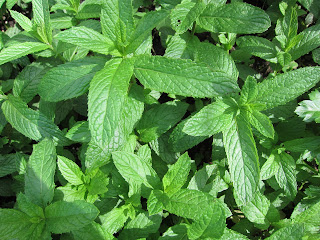 |
| Mint from our garden |
There are different types of mint. The most commonly used ones especially in kitchens are spearmint and peppermint.
Mint is rich in Vitamins A and C. It also contains some Vitamin B2. The essential minerals mint contains are manganese, copper, iron, potassium and calcium.
Mint is well known to help with digestion (homemade peppermint tea is strongly recommended. To make this tea, you just need to boil some water and put some fresh mint leaves in it and wait for 5-10 minutes before drinking).
Mint's medicinal properties aren't limited to its aid in digestion. It
- has anti-cancer properties both in preventing and healing and are good antioxidants (antioxidants are good for protecting against cancer).
- helps opening up respiratory passages and airways,
- is good for relieving cold and flu symptoms.
- has proven itself in some muscle relaxation and is calming.
- is used as a mild sedative (no wonder why mint is often used in aromatherapy such as massage oils).
- is proven to help bad breath problems and
- crushed mint leaves help whitening teeth (most toothpastes include mint in them).
- is a very good cleanser for the blood.
Mint is sold both dried and fresh at almost every supermarket these days (if you want to know how to make ground mint at home, click here). Fresh mint can stay for upto a week when put in water and the water is changed regularly. However, I really like it when they are 'really fresh'.
We grow some mint in the garden and I can easily claim that they are one of the easiest herbs to grow in a pot or on a garden bed. If interested, let me know and I can write about how to grow mint in the future. Also, let us know how you consume mint. You can either e-mail me (contactmrslucky.gmail.com), or just click 'comments' below and write there.

No comments:
Post a Comment
I love comments. Thank you for leaving one!